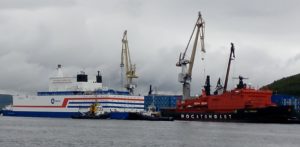New report suggests that one rapid approach to produce hydrogen and ammonia for shipping could be to use electricity from nuclear power plants
While there has been some talk recently about putting nuclear power onto commercial ships as part of the decarbonisation journey, another proposal has emerged that may sway some of those who are sceptical about such a move. The suggestion is to use nuclear power to generate the electricity that is needed to make the zero carbon fuels that are rapidly being the first choice alternative.
Shipping companies in all their shapes, sizes and forms, face a key common challenge in having to first reduce their vessel emissions and then bring them to a virtual zero.
A number of options are under research, which range from those which will still emit CO2 from a ship’s funnel, but could be made with captured CO2 or from bio-sources (hence make them carbon neutral), or without CO2 being emitted (hydrogen based fuels).
Some nuclear power stations need hydrogen. It is used in hydrogen water chemistry to mitigate stress corrosion in boiling water reactors and in generator cooling.
Hydrogen is largely made today through the reformation of natural gas or coal gas means it generates large volumes of green house gases. The discussion and projects in society are about the transition to hydrogen that can be made using electrolysis.
This is where the colour-coding of hydrogen comes in. Grey hydrogen is that made with the reformation of natural gas into CO2 and hydrogen, Blue hydrogen is where the CO2 is captured (using the same process) and green is where the hydrogen is made with electrolysis where the electricity needed for the electrolysis comes form renewable sources (i.e. wind).
In the US some nuclear power stations are already funded by the Department of Energy to demonstrate hydrogen production capabilities. In a recent disclosure document Exelon Corporation, a US nuclear power producer stated how some of its R&D efforts are focused on how hydrogen can be used in a clean energy economy in a variety of applications, such as energy storage or as a clean fuel for transportation.
“In 2019, Exelon received a conditional commitment from the DOE to co-fund a demonstration of a hydrogen electrolyser at a nuclear plant site and began with project planning in 2020. The project will demonstrate dynamic operation of an electrolyser in a manner that paves the way for at-scale, electricity price-responsive, hydrogen production. In addition, it will supply hydrogen internally to the associated nuclear plant.”
Other US nuclear companies involved in DoE funded projects include Xcel Energy and in the UK EDF partnered with the UK government in a consortium looking at hydrogen production and a 1MW PEM electrolyser to generate hydrogen at the Heysham nuclear power plant in North West England.

But a paper from the Clean Air Task Force in the USA suggests that nuclear power stations could be better used as a part of the transformation, especially given the proximity of many nuclear power plants to coastal areas.
Report author Brett Rampal is CATF’s director of nuclear innovation. He believes there is huge potential for nuclear power to be used to generate clean electricity given how nuclear ´power is often used for base load on electrical grids and when there is excess can be used to generate hydrogen for energy storage and for transportation needed.
“The majority of hydrogen produced around the world is produced through steam methane reforming, which is a relatively carbon intensive process where methane is split apart to produce hydrogen. The reactors nuclear power plants around the world that use hydrogen in their operations or are usually sourcing that steam methane reformed hydrogen in their in their operations. The Exelon demonstration is going to be at the Nine Mile Point nuclear power plant,” he says.“Existing power plants use the hydrogen in chemistry control in their water in some reactors, and in others, they use them to keep the generators cool. That is a not an insignificant amount of hydrogen.”
This is why, he adds, the US Department of Energy and the nuclear power companies are looking at using nuclear power to be able to generate their own electricity and thus hydrogen, and even generate excess for other uses, such as transportation and shipping.
“Pairing electrolysis technology with an always available clean source of energy, or electricity, helps support overall economic production of zero carbon fuels,” he says.
So why nuclear power to make the fuel and not wind or solar?
But nuclear power plants are expensive, and certainly remain controversial, with some countries having a very cool attitude to nuclear power due to pervieved risks. So will it be hard to convince an industry to use nuclear power derived hydrogen or ammonia?
“Depending on your region and your area the option for pairing electrolysis with renewables might be the best option for you, but for some regions or some areas, that just might not be possible.
“Renewables, while they are great and a growing source of our electricity, they tend to be relatively disperse, take a lot of land use, so the opportunities for nations or locations that are very reliant on marine shipping, you know, such as Pacific island nations, or other countries with land use and land density problems, would probably struggle to produce or build out the renewable infrastructure to support the decarbonization of their own electricity needs, and expanding to produce additional zero carbon fuel sources”
.
Floating power stations
The CATF report also points the potential to model Russia and China with their floating nuclear power plants, and there are already projects looking at this. One company in Denmark, Seaborg Technologies has begun looking at putting its Compact Molten Salt Reactor nuclear technology on barges. There are at least three floating nuclear power stations acting as reference bases..
Russia’s Academic Lomonosov is a floating power station that was built in a Russian shipyard and towed into the North East Russian Arctic to supply power.
China’s Bohai is also building a floating nuclear power plant. nuclear power station (as well as a Chinese nuclear powered icebreaker and nuclear powered submarines). It is due for completion this year.
The CATF paper suggested that this model of floating nuclear power plants could be developed for key bunkering hubs to generate electricity that can be used in the electrolysis of hydrogen and ammonia fuel production for shipping.
These two were not the first of their kind. In the US an old world War Liberty Ship was converted into a floating nuclear power station. HM-1A Sturgis provided power for the Panama Canal in the late 1960’s and early 1970’s.































